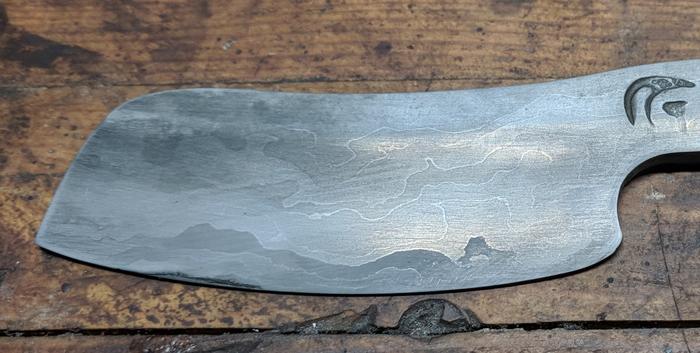Results 1 to 10 of 15
Thread: Tempering question
Hybrid View
-
12-10-2017, 08:51 PM #1
 Tempering question
Tempering question
Hi all,
I'm hoping in the next day or two to get to the hardening/tempering stages with the frankenrazor I'm making from 11 vintage blades (some details here: http://straightrazorpalace.com/forge...ml#post1790264).
I did some testing with a bit of the billet and it seems I'm stuck with water quenching. Oil did nothing, but the quench bucket got it nice and hard. Now, assuming that I'm able to harden the blade without the thing shattering - I'm used to using oil quenching steels for knives so water makes me a bit nervous - what would you guys try for tempering? Would my usual few cycles in a ~400 degree (f) toaster oven that i use for knives be a safe bet?
Ah, the joys of mystery steel...
It was in original condition, faded red, well-worn, but nice.
This was and still is my favorite combination; beautiful, original, and worn.
-Neil Young
-
12-10-2017, 10:46 PM #2

How thick was the piece you tested?
I routinely quench water quench steel in hot oil. The thing is that if the razor is ground thin enough (1 mm, give or take) oil will quench fast enough to harden, without any of the risks of using water.
The more thermal mass, the more it really matters. And if you have a laminate with iron sides, it also matters a great deal. But for high carbon steel, oil can be fast enough if the piece is thin enough.Til shade is gone, til water is gone, Into the shadow with teeth bared, screaming defiance with the last breath.
To spit in Sightblinder’s eye on the Last Day
-
-
12-11-2017, 01:57 AM #3

Bruno, you're a freakin' star!
Re-tested with a piece that resembled the blade profile and oil worked. Best thing is, despite a spot of dodgy weld appearing near (but thankfully not right on) the edge, it appears to have survived, and is now baking in the oven. Many thanks!
Also, before hardening, I thought I'd see what a dunk in ferric chloride might do once I had everything sanded down nicely. The pattern was a nice surprise:

You can see the bad weld pretty clearly there. I really thought it might blow up when quenching.
It was in original condition, faded red, well-worn, but nice.
This was and still is my favorite combination; beautiful, original, and worn.
-Neil Young
-
The Following 5 Users Say Thank You to Cangooner For This Useful Post:
HARRYWALLY (12-13-2017), jmabuse (12-12-2017), ScottGoodman (12-11-2017), sharptonn (12-12-2017), spazola (12-11-2017)
-
12-11-2017, 05:09 AM #4aka shooter74743




- Join Date
- Sep 2009
- Location
- SE Oklahoma/NE Texas
- Posts
- 7,285
- Blog Entries
- 4
Thanked: 1936
I temper in the house oven. I picked up a old tin pan at a garage sale and put about 1/2" of play sand in it. I pre-heat to whatever temp I am shooting for (varies for steels, my norm is 375-425F). I have another temp guage inside the oven to double check the temperatures before adding the steel. I usually go for two one hour cycles for steel under 3/8"
Southeastern Oklahoma/Northeastern Texas helper. Please don't hesitate to contact me.
Thank you and God Bless, Scott
-
-
12-11-2017, 04:17 PM #5
-
12-11-2017, 06:05 PM #6

the razor is looking great!!
the way I like to find the right tempering temp for a steel is to get a test piece quenched, then grind it to as close to the edge geometry that your finished blade will be, then start real low on the tempering in a toaster, then creep up in 15-25 degree increments {use at least a pair of thermometers as kitchen ovens and toasters are usually not very accurate or consistent with the dial, and then note the thermometer readings in your log books for the next time you need to make an educated guess}doing edge flex and edge deformation tests until you get the edge to fail the way you want it to, and then that is your temperature. with mystery steel you might only have enough to do one or two tests though, so then you do the educated guess along with the one or two tests and then hope for the best, or err on the side of softer or harder, whichever suits the finished blade best.
something I noticed on the last couple Damascus razors I made is to cut down on the time in the ferric for etching. I had one that I thought I did a horrible job of welding up, but then found that the ferric was eating through the edge where the 1095 was. they looked like flaws, but weren't. so my 10 minute etch time is way too much and next time ill go in 1-2 minute intervals and ease up on the etch I'm after.
-
The Following User Says Thank You to caltoncutlery For This Useful Post:
Cangooner (12-11-2017)
-
12-11-2017, 07:19 PM #7aka shooter74743




- Join Date
- Sep 2009
- Location
- SE Oklahoma/NE Texas
- Posts
- 7,285
- Blog Entries
- 4
Thanked: 1936
Cheap fingernail polish is great to protect the edge.
Southeastern Oklahoma/Northeastern Texas helper. Please don't hesitate to contact me.
Thank you and God Bless, Scott
-
12-11-2017, 07:29 PM #8

This project has been a treat to watch so far
One man's opinion...
-
The Following User Says Thank You to Butzy For This Useful Post:
Cangooner (12-11-2017)


 43Likes
43Likes LinkBack URL
LinkBack URL About LinkBacks
About LinkBacks











 Reply With Quote
Reply With Quote


